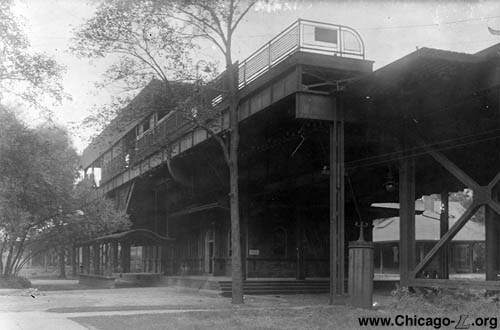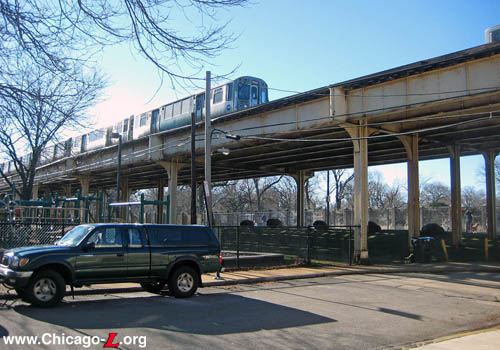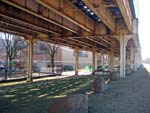|

The joint Northwestern "L"-St. Paul Railway Buena station house is seen looking south. Note the large size of the building compared to other "L" stations. The station's signature porte-cochere is visible on the left, and the typical Northwestern Elevated platform looms above. For a larger view, click here. (Photo from the CTA Collection)
|
Buena
(4200N/1100W)
Buena Avenue and Kenmore
Avenue, Buena Park (Uptown)
Service
Notes:

|
North Side
Division
|
Quick Facts:
Address: TBD
Established: May 31, 1900
Original Line: Northwestern Elevated Railroad
Previous Names: none
Skip-Stop Type: n/a
Rebuilt: n/a
Status: Demolished
History:
The history of Buena station is an unusual one, especially for a station that was, for all intents and purposes, a neighborhood stop with relatively little traffic (it typically ranked amongst the lowest ridership stations on the North Side "L" most years it was open).
The station's complicated history and unusually large and ornate design (particularly for a neighborhood local stop) owes itself to the facility's relationship to the adjacent Chicago Milwaukee & St. Paul Railway (the "St. Paul"). The Northwestern Elevated's structure was parallel to the existing St. Paul steam railroad between Graceland (Irving Park) Road and Wilson Avenue. The St. Paul's Graceland station was already located at Buena (pronounced "bewennah" by Chicagoans) Avenue, and the Northwestern decided to locate a local stop on the "L" at the same location.
Rather than build a new "L" station completely separate from the adjacent St. Paul station, it was decided to have the "L" and the St. Paul share a station at this location. Why this decision was made is unclear, as the Northwestern planned to only have local trains stop at Buena; the Northwestern's terminal at Wilson a half-mile north, adjacent to the St. Paul's Sheridan Park station, perhaps seems like a more natural location for a shared facility. Nonetheless, the facility was planned to have a shared station house situated underneath the "L"'s elevated structure, on the east side of the St. Paul's ground-level double-track line, with stairs up to the "L" platforms and ground-level boarding for the St. Paul.
What is less clear is the origin of the station house that served the Buena station. Some sources indicate that the station house that was used was a recycled use of an existing facility1. Indeed, the Sanborn Fire Insurance Map of the area from 1894 (three years before the Northwestern's elevated structure would reach that point, and six years before the Northwestern would begin service) shows a long building labelled "Buena Park Station" on the eventual site of the joint building. On the other hand, the outline of the building in 1894 does not precisely correspond with the joint station that would eventually exist, especially in the curved north elevation (the joint building's four walls were flat). And other sources date the construction of the joint station facility to 18962, the year after the Northwestern Elevated's drawings for the station are dated. Earlier drawings from the Northwestern Elevated show a station of similar shape to that on the 1894 Sanborn map. It may be possible that the original intent was to reuse an existing earlier St. Paul station, but that ultimately it was decided to build a new facility specifically designed to be a joint station house.
Station Design
Whatever its origins, the station house that served the "L" when the Northwestern Elevated opened in 1900 was a brick and terra cotta structure, 83 feet long by 28 feet wide. The architectural drawings for the station bear the signature of J.A.L. Waddell, listed as Consulting Engineer. John Alexander Low Waddell (1854-1938) was a prolific civil engineer and designed thousands of structures, including many bridges. He was retained by Charles Tyson Yerkes to prepare designs for his Northwestern Elevated and Union Elevated (Loop) lines. Waddell designed a number of stations as well for these two "L" companies, although in most cases his designs were later revised and simplified -- by architect William Gibb, in the case of the Northwestern Elevated -- before being built. However, Buena station seems to be one of Waddell's designs that was actually built as originally designed, as the few existing photos of the station match the designs in his signed drawings.
Waddell's designs for the Northwestern Elevated stations were relatively grand and highly ornamental for the "L", and Buena was no exception. The Classical Revival exterior was constructed of brick with terra-cotta trim, pilasters, and other ornamentation. The bold modeling of the
details, especially the columns and segmented arched windows, is
characteristic of Italianate work of the late 19th century. The
building featured unglazed terra
cotta pilasters with composite capitals between all the windows and doors. The top of the building featured a heavy cornice with
classical ornamentation. More in fitting with its mainline railroad station lineage, the building had wide overhanging eaves, unusual for an "L" station. Perhaps one of the station's most unusual features was its porte-cochere -- a portico-like structure through which a horse and carriage could pass in order for the occupants to alight under cover, protected from the weather -- on the east elevation, facing the circular driveway in front of the station. Certainly not a feature found at most "L" stations.
The interior was divided roughly in half, with the Northwestern Elevated using the north half of the building and the St. Paul using the south half. Each half had its own doors from the outside on both of the east (street-facing) and west (St. Paul track-facing) sides, but were also connected internally though a central corridor. The "L"'s facility featured a large waiting room with benches under the windows. On the south side of the room were restrooms in the corners. A large central stairway ascended up toward the middle of the building from the south half of the room, with a ticket booth located at the base and a single turnstile regulating access. The stairway rose to a mezzanine level above the ceiling, where it split into passageways leading to stairs to the north- and southbound platforms.
The south half of the building was used by the St. Paul, with a baggage room and the aforementioned corridor dividing the two halves. The St. Paul's side featured a large ticket office in the middle of the west side (with a half-octagonal projection on the building's exterior, typical of many mainline railroad stations of the period) and men's and women's restrooms in the middle of the east side, with a five-foot hallway between the two. These served to divide the remaining space into two sections, the north portion of which was designated the men's waiting room and the south half the women's waiting room. Oak benches lined the north and south walls of the room.
The walls of both halves of the interior were plaster with oak beadboard wainscotting on the lower portion and wooden doors and moldings. The ceiling was made of decorative pressed steel.
The dual side platforms at Buena were typical of those the Northwestern built for its local stations, covered in the center by two peaked-roof canopies of steel supports with a gently-curved bracket and intricate latticework, covered by a corrugated metal roofing. The platforms had wooden decks and railings which consisted of tubular railings and posts with panels of decorative, ogee patterned metalwork inside. The platforms were outboard of the outer of the line's four tracks, served by local trains and inaccessible by the expresses utilizing the inner tracks.
Later Developments
Northwestern "L" service was extended north of Wilson to Central in north
Evanston on May 16, 1908 over the electrified tracks of the St. Paul railroad.
Coincident with the extension of "L" service over the St. Paul's
tracks, the steam road cut their commuter operations back from
Wilmette to their Sheridan Park station adjacent to the Wilson "L" stop. In June 1908, the St. Paul was running just two trains a
day between Union Station and Sheridan Park. They ran this limited
service until June 1917, after which the former Evanston Division of
the CM&StP just handled freight. With the abandonment of passenger service, the St. Paul no longer used their half of the Buena station. In the 1920s, the Chicago Rapid Transit Company (successor of the Northwestern Elevated) drew up plans to convert the former St. Paul waiting room into a telephone exchange, removing the restrooms and most of the ticket office and the associated interior walls, and installing new partitions, a new "asbestone" floor over the old flooring, and associated telephone equipment. The southwest corner would be partitioned off into a battery room. The "L" continued to use the north half of the building as their passenger station, as originally designed.
Buena station survived the Chicago Transit Authority's 1947 takeover, but was one of 23 stations closed in the CTA's North-South
Route service revision on August 1, 1949. The concept of "local"
stations, of which Buena's low usage was only suited, was not a part
of the A/B skip
stop concept and the station was closed.
The Buena station was adjacent to the Buena Interchange Yard, built on the former St. Paul right-of-way in 1920 as the location for the "L" to interchange freight with mainline railroads. (See the "L" Freight Service page for more details on this operation.) After ceasing to function as a passenger station, the Buena station house was converted into a freight office, and continued in this use into the 1960s. In 1961 or '62, a partial demolition of the building was performed. Half of the station house was removed and the open end of the remaining half was bricked up. It may have been used for storage after that. When the other half was removed is unclear. Today, the entire station is gone.
|

A Howard-bound Red Line train passes for the former location of the Buena station, looking southwest on January 2, 2011. The large station house was located under the elevated structure, in the wide opening in the middle without center support columns. The short beams cantilevered off the track structure are remnants of the platform supports. For a
larger view, click here. (Photo by Graham
Garfield)
|

|

|

|
Notes:
- Moffat, Bruce, The "L": The Development of Chicago's Rapid Transit System, 1888-1932 (Bulletin 131). Chicago: Central Electric Railfans' Association, 1995, 192.
- Mess, Dennis, James Buckley, and Ted Schnepf.
"Evanston via Chicago, Milwaukee and St. Paul." The Milwaukee
Railroader. June 1984, 12.







